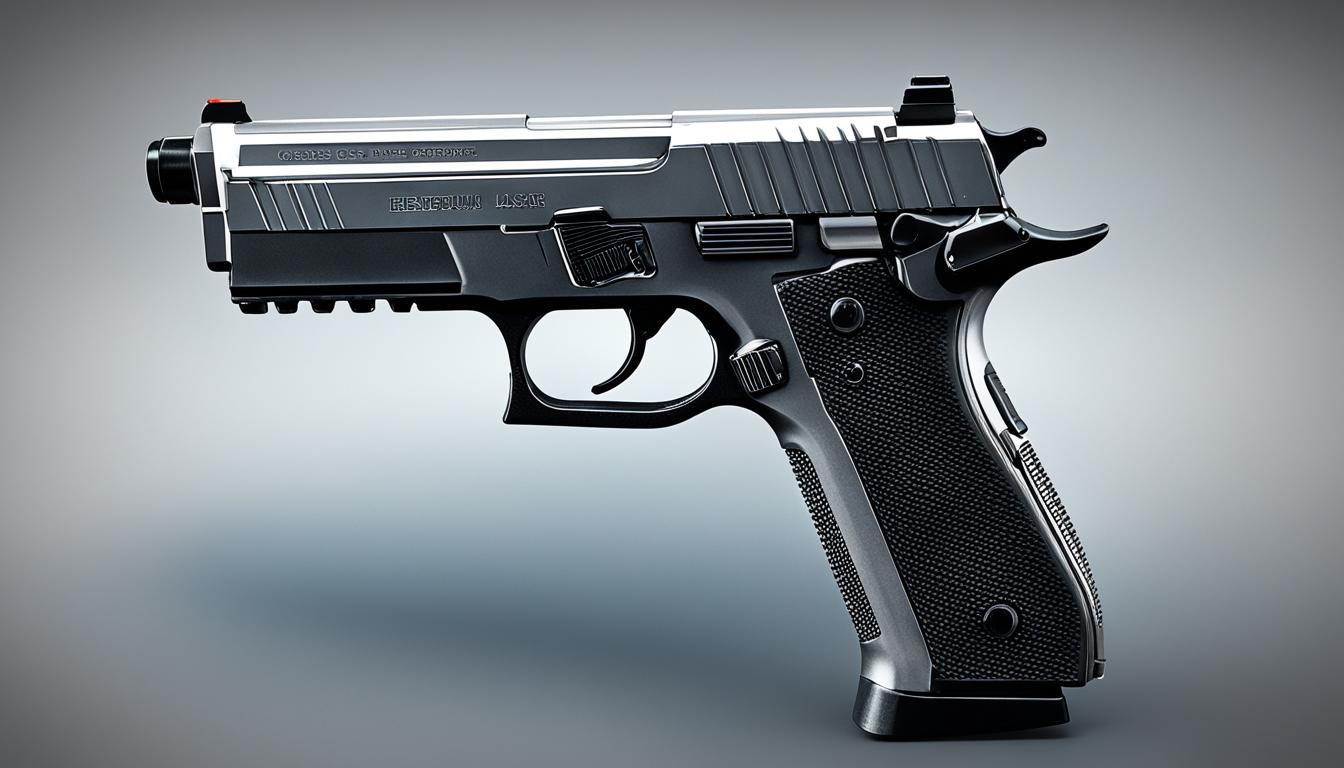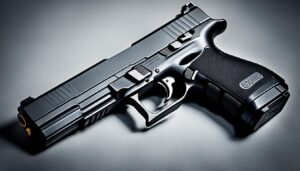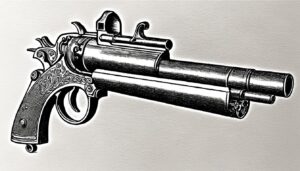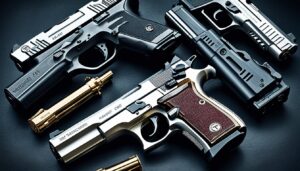Welcome to the world of handguns, a realm where precision engineering meets personal defense and sporting tradition. In this introduction, we’ll breeze through the handgun basics, highlighting the key pistol features, firearm functions, and the sophisticated shooting mechanisms that make up these iconic tools. Whether you’re a novice looking to understand the essentials or an enthusiast aiming to refine your knowledge, we’ve got your six covered.
As a staple in both self-defense and law enforcement, handguns offer a blend of portability and power. Their design involves a meticulous combination of parts including the barrel, which directs the bullet; the trigger, which sets the action in motion; and for revolvers, the cylinder that houses ammunition, or the magazine in semi-automatic pistols, which feeds the ammunition into the chamber. As we pull the trigger in this exploration, we’ll unpack the intricate dance of mechanics that enable a handgun to discharge a projectile with precision and reliability.
The Origins and Evolution of Hand Guns
The tapestry of firearm history is rich and complex, with the development of pistols serving as a cornerstone in the chronicle of personal armaments. Hand guns, in their earliest incarnations, emerged from the fog of the gunpowder revolution, transforming warfare and self-defense.
The initial foray into portable firearms brought forth the hand cannon, a primitive ancestor of today’s sophisticated weaponry. As innovation spurred historical handguns forward, the wheellock mechanism paved the way for more reliable and user-friendly pistols, marking a significant leap in gun technology.
The advancement of firearms continued with the introduction of flintlock pistols, which dominated the landscape of personal armaments for centuries. However, it was the inception of the percussion cap in the 19th century that truly revolutionized the field, allowing for quicker and more reliable ignition.
What followed was a period of rapid innovation, culminating in Samuel Colt’s patent of the revolver in 1836—a design that would come to symbolize the Western frontier and remain influential to this day.
“The revolver…has obviated the necessity of carrying in the saddle two or three pairs of pistols, and of course diminishes the chance of being left without any at all.” – Colonel George Hanger, 1814
- Hand Cannon (14th Century): The rudimentary beginnings, using a touch hole for ignition.
- Wheellock Pistol (16th Century): A mechanical marvel of its time, providing a spark for ignition.
- Flintlock Pistol (17th Century): The standard for military and civilian use for over two centuries.
- Percussion Cap Revolver (19th Century): Samuel Colt’s design that revolutionized repeatability in firearms.
| Epoch | Firearm Type | Innovations |
|---|---|---|
| 14th Century | Hand Cannon | Introduction of portable gunpowder weapons |
| 16th Century | Wheellock Pistol | Revolutionary mechanical ignition system |
| 17th Century | Flintlock Pistol | Widespread adoption, improved reliability |
| 19th Century | Percussion Cap Revolver | Enhanced repeatability, faster loading times |
The transition from black powder to smokeless powder in the late 19th century marked another pivotal moment in firearm evolution. This leap in technology offered numerous benefits, such as less smoke upon discharge and the ability to create higher chamber pressures, leading to increased bullet velocity and improved accuracy.
As we gaze upon the lineage of pistols, it’s evident that the story of hand guns is not merely one of necessity but also one of continuous innovation. From their rudimentary beginnings to the precise instruments of today, hand guns have been shaped by the needs, technologies, and talents of their time.
Types of Hand Guns and Their Distinct Characteristics
Delving into the diverse world of handguns, one discovers various models with unique traits catering to different preferences and requirements. From the distinguished revolver with its historical legacy to innovative semi-automatic models and discreet derringer guns, each type offers distinct advantages for firearm selection and concealed carry weapons.
Revolvers: The Classic Six-Shooter
Known for their dependability and classic design, revolver types have stood the test of time, providing a reliable firearm option for enthusiasts and professionals alike. Let’s take a closer look at some of the well-regarded models:
- The Smith & Wesson Model 686, praised for its precision and durability
- The Ruger GP100, favored for its robust build and versatility in ammunition selection
- The Colt Python, an icon in revolver craftsmanship and smooth action
Revolvers are often celebrated for their ease of maintenance and straightforward mechanics, making them a perennial choice among gun aficionados.
Semi-Automatic Pistols: Modern-Day Standard
Semi-automatic models are the go-to for many law enforcement agencies and military units worldwide due to their larger magazine capacities and rapid reload features. Some notable semi-automatic pistols include:
- The Glock 17, renowned for its reliability and widespread use among police forces
- The Beretta 92FS, with its exceptional open-slide design and historical military significance
- The SIG Sauer P320, modular and adaptable, the chosen sidearm of the U.S. Army
Advancements in semi-automatic technology continue to refine these firearms, ensuring they remain a dominant presence in the market.
Derringers: Compact and Concealable
In the realm of concealed carry weapons, derringer guns offer an unmatched level of discreetness due to their compact size. Here are a few examples:
- The Bond Arms Snake Slayer, designed for ultimate concealment without compromising on power
- The North American Arms Mini-Revolver, known for being one of the smallest revolvers available
These pocket-size handguns are particularly appealing for those prioritizing portability and concealment.
| Handgun Type | Notable Features | Popular Models |
|---|---|---|
| Revolvers | Reliability, classic design | Smith & Wesson 686, Ruger GP100, Colt Python |
| Semi-Automatic Pistols | Higher magazine capacity, rapid reload | Glock 17, Beretta 92FS, SIG Sauer P320 |
| Derringers | Concealable, compact size | Bond Arms Snake Slayer, North American Arms Mini-Revolver |
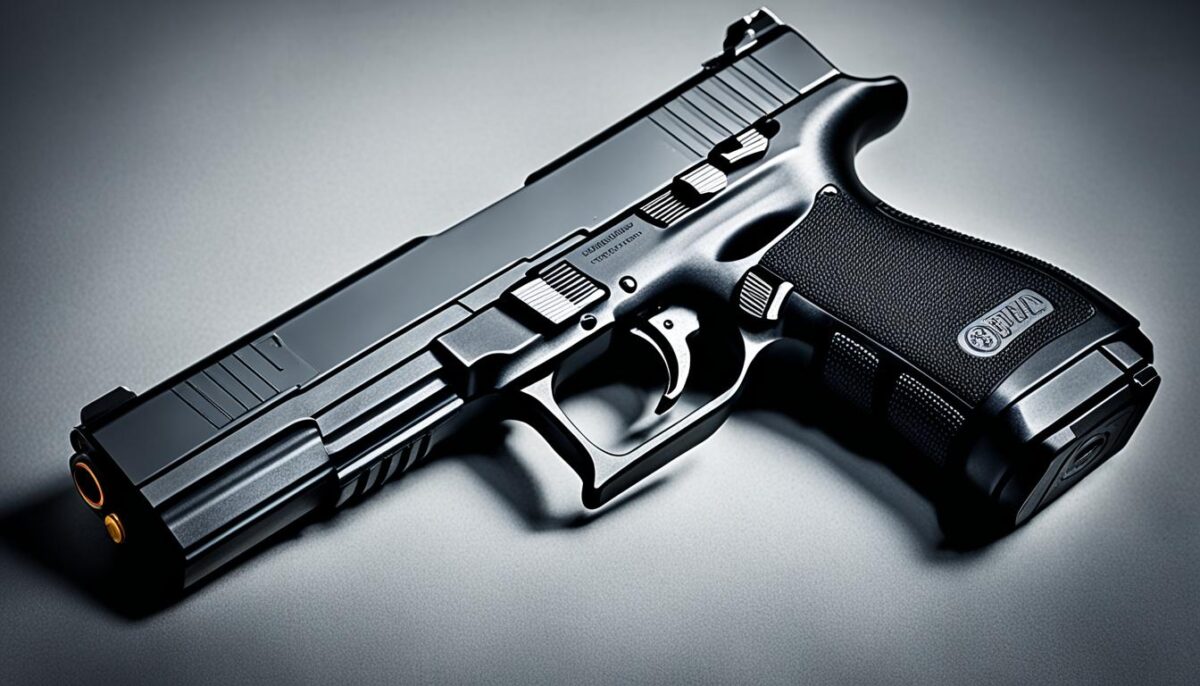
Different Calibers and Their Impact on Hand Gun Performance
When selecting a handgun, one of the critical decisions facing enthusiasts and professionals alike is the choice of caliber. This seemingly small detail significantly influences shooting accuracy, handgun stopping power, and overall shooting experience. Understanding the diverse range of handgun calibers can empower you to choose the best option tailored for your specific needs, whether that’s home defense, target shooting, or concealed carry.
A bullet size comparison is a great starting point for appreciating the physical differences between calibers. From the fine precision of the .22LR to the commanding presence of a .45 ACP, the diameter of the bullet can greatly impact both the power it delivers and how it feels to shoot. Let’s delve into the particulars of caliber selection and how it affects performance.
- 9mm: Balance is the hallmark of the 9mm caliber. It is renowned for adequate stopping power without excessive recoil, making it a universal choice for personal defense and law enforcement.
- .45 ACP: For those seeking more substantial firepower, the .45 ACP delivers. With its larger bullet size, it’s credited with superior stopping power, at the cost of greater recoil.
- .22LR: Favored for target shooting due to its low recoil and cost-effectiveness, the humble .22LR caliber allows for prolonged practice sessions to enhance accuracy without shooter fatigue.
- .38 Special: Well-regarded by revolver aficionados, the .38 Special strikes a balance between manageable recoil and sufficient stopping power for self-defense scenarios.
It is essential to recognize that a firearm’s muzzle velocity, noise, and ability to neutralize a threat are all contingent on the caliber you choose. Manufactures develop their handguns with specific calibers in mind, ensuring that every aspect from the barrel length to the grip size synergizes with the characteristics of chosen ammunition.
“The right caliber can make all the difference in a hand gun’s performance – it’s about finding the perfect combination that fits the shooter’s capabilities and situational needs,” notes a distinguished ballistic expert.
Ultimately, the choice in handgun caliber should reflect a congruency between user comfort, intended purpose, and cartridge performance capabilities. With a wide spectrum of calibers available, shooters have the privilege of tailoring their hardware to their personal preferences and requirements.
Hand Guns Safety and Responsible Ownership
Owning a hand gun comes with a profound commitment to firearm safety and responsible gun ownership. It is not only about protecting oneself but also about ensuring the security and peace of mind of those around us. A well-informed hand gun owner recognizes the significance of safety mechanisms integrated into firearms and the legalities that govern their use. This section is dedicated to guiding hand gun owners through the essential safety practices, proper handling and storage of firearms, and understanding the overarching legal frameworks.
Understanding Gun Safety Mechanisms
Modern firearms are built with numerous safety features designed to minimize the risk of accidental discharge. The presence of manual safeties, grip safeties, and firing pin blocks are integral components that require deliberate action by the operator to discharge the weapon. These mechanisms ensure that a firearm is less likely to fire without intentional manipulation, providing an additional layer of security against unintended consequences. Knowledge and familiarity with your hand gun’s specific safety features are the foundation of responsible gun ownership.
Safe Storage and Handling Practices
Safe storage solutions are paramount to prevent unauthorized access to firearms. This includes utilizing gun safes, cable locks, or trigger locks that are designed to keep weapons secure while not in use. Proper handling also entails adhering to basic firearm safety rules such as treating every gun as if it is loaded, keeping the muzzle pointed in a safe direction, and never placing a finger on the trigger until ready to shoot. These practices are not only beneficial for the owner’s well-being but are also critical for safeguarding the community at large.
Legal Responsibilities of Hand Gun Ownership
Complying with gun laws is a critical aspect of gun ownership. Registration, obtaining necessary permits, and staying updated with federal and state regulations are all part of the legal responsibilities that come with owning a hand gun. As these laws can frequently change, staying informed through credible legal sources and guidelines is essential. This ensures that hand gun owners are excelling in their civic duty by adhering to the laws set forth for the protection and safety of everyone.

